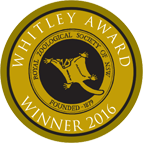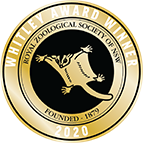Review of ‘An Atlas of the Birds of NSW and the ACT Volumes 1 & 2’
Julian Reid
An Atlas of the Birds of NSW and the ACT. Volume 1: Emu to Plains-wanderer.
By Richard Cooper, Ian McAllan and Brian Curtis,2014
720 pages, 183 species; $135.
An Atlas of the Birds of NSW and the ACT. Volume 2: Comb-crested Jacana to Striated Pardalote.
By Richard Cooper, Ian McAllan, Christopher Brandis and Brian Curtis, 2016.
688 pages, 165 species; $135.
The publisher is the New South Wales Bird Atlassers Inc. See https://www.nswbirdatlassers.org.au//; also available from CSIRO Publishing (http://www.publish.csiro.au/).
When Volume 3 is finished in a year’s time this mighty effort by a small, dedicated bunch of amateur ornithologists will have culminated in over 2000 pages of published mapping and analysis of the distribution of every bird species in New South Wales. Led by Dick Cooper, and ably supported by Ian McAllan’s encyclopaedic and arcane knowledge of the NSW ornithological literature and Brian Curtis’s computer and databasing skills, Chris Brandis and others, the NSW Bird Atlassers kept on surveying birds in 10-minute grid blocks when the first Australian Bird Atlas (1977-81) left off. Consequently, and only in this state, there is a continuous record of moderately fine-scale bird distribution and species’ reporting rates from 1977 to the present, importantly using the same methodology – virtually a 40-year span. The authors have scoured the historical literature and members’ notebooks to compile an historical atlas for each species, and where obvious changes in distribution have occurred these are presented as maps. They also sourced data from Birdlife Australia, other birding societies and government agencies and institutions. All up they compiled over 5.5 million bird records, over half of which were contributed by NSW Bird Atlassers members, while the various RAOU/BA schemes contributed almost 2 million records.
Three standard maps are presented for most species apart from pelagics – two at the 10-minute resolution of roughly 18.5 km north-south by 15.5 km east-west, namely total distribution and breeding distribution, and a third map of reporting rates at the half-degree scale using surveys from 1971 to 2006. For some species, such as the Australian Brush-turkey, extra maps of historic change are shown, and in this case we see that brush-turkeys used to occur out west, from the Border Rivers region, through the Pilliga Scrub and the Warrumbungles, out even to Nyngan; today, a few birds might remain in the Mount Kaputar district, but otherwise they are restricted to the east coast and adjacent ranges, south to Nowra. Changes in this species abundance and distribution are much more complex than this brief sketch indicates, and the authors devote a full page of text to these population shifts and associated environmental and (human) social changes that may account for them (see pp. 38-39, Vol. 1). Sadly, however, I can report that brush-turkeys never occurred around Cowra which instead was occupied by the Malleefowl historically (long since gone). It is interesting to note though that the two species formerly must have had overlapping ranges in the Nyngan to Coonabarabran area, presumably separated on habitat differences.
As well as the maps, for all but the rarest or vagrant birds each species’ seasonal patterns of distribution and breeding are addressed in a table of reporting rates by season across nine regions and by graphs for NSW as a whole. Finally, a graph of annual reporting rate over 20 years from 1986 to 2006 shows any obvious recent trends through time, whether increase, decrease or more complex, and these trends were assessed for statistical significance through regression analysis. For some species where recent changes appeared to vary in different parts of the geographic range, these trend analyses were broken down by region. For example, the Budgerigar (p. 302, Vol. 2) shows a complex (‘rollercoaster’) pattern of decline, with three downswings and two upswings from an initially high reporting rate in the late 1980s (6-8%), and with several years in the noughties having state-wide reporting rates of 1% or less. These swings and roundabouts were still apparent after restricting analyses to the species’ core western NSW range. We could conclude cautiously, that overall, budgies are being seen less frequently across NSW, despite being aware that their occurrence will vary greatly from one location and year to the next given the species’ pronounced nomadic tendencies. Moreover, the authors note that there has been a strong ‘recovery’ in reporting rate during and since the wet years of 2010 and 2011.
The authors are acutely aware and make the point numerous times that since their period over which reporting rates were assessed for trends ended in the middle of the severe ‘Millenium Drought’, this increases the likelihood of obtaining significant decreasing trends through time. Nevertheless, given this caveat, I have tabulated the trends for the land bird species covered in these two volumes that occur regularly in wooded habitats in the Cowra district. The results are alarming. Of 64 native species, 44 exhibited a significant decline in reporting rates over the 20-year period, 8 an increase, and 12 were stable. All increaser species were non-passerines, mostly parrots and cockatoos. Thornbills and Australian ‘warblers’ (Speckled Warbler, Heathwrens, Gerygones, Southern Whiteface) are nearly all in severe decline, as are most raptors. The Superb Parrot is one of the increasers. Although there are statistical issues with the simplistic regression approach used to derive significance levels, the graphed trends in annual reporting rates speak for themselves.
Short articles on aspects of NSW birds and their distribution appear in both volumes, including a brief history of ornithology in NSW and the ACT (Volume 2), while a brilliant biogeographic analysis appears in Volume 1 (although it makes me blush to describe it thus!). For those of you, like me, who love poring over maps, and appreciate detail, this series of books is for you – observing the patterns and gaps in distribution will make you wonder ‘Why?’. Moreover, you will know exactly where to go to find that elusive bird you have always wanted to see. The books are strongly bound, hardback editions, and will look impressive in your ornithology bookshelf. Importantly, all sales will assist this fine organisation to cover the costs of publishing the entire series, and so promote further bird conservation activities which is their primary objective.
Our woodland birds, particularly the smaller sedentary insectivores, are in a parlous state and face an uncertain future in the medium to long terms.
In the tables below I have summarised the Atlas’s trend data for three taxonomic groups. The Black-shouldered Kite (no trend) was the only raptor common the Cowra area not to show a state-wide significant decrease in reporting rates. The Psittaciformes show some interesting patterns. First, the smaller species within a subgroup – Cockatiel within cockatoos, Little Lorikeet within the keets – and smaller species generally (Swift Parrot, Turquoise Parrot, Budgerigar) are generally declining. Second, there appears to be a systematic bias in the data causing species to show either a declining trend in time (Galah, Crimson Rosellas) or no significant trend (Eastern Rosella, Red-rumped Parrot), when generally we believe these to be increaser species. Sophisticated statistical analyses that can account for geographical and temporal changes in survey effort (search method etc), and spatio-temporal dependencies in the data more generally, are required to see if there are explanations for the apparent bias. A third trend apparent to me when looking at all the landbirds covered in the first two volumes is that fewer wet forest species are in decline compared with typical woodland birds of the sub-humid woodlands and dry sclerophyll forests, and so for instance of the thornbills in our area, only Brown Thornbill did not exhibit a significant decline; nor did the White-throated Gerygone. In contrast, dryland representatives of these species – Inland Thornbill, Western Gerygone – have undergone significant declines. Other examples of wet country (and large) increaser species that will probably become more common in the Cowra district are the Channel-billed Cuckoo and Eastern Koel, both showing state-wide increases at the highest level of significance; by comparison, the four ‘common’ smaller cuckoos in our area show highly significant declines. Increasers and decreasers can largely be identified on the basis of size (both absolute and relative within a taxonomic group), taxonomic group, diet and climatic affinity.

Julian Reid
From Cowra comments An occasional newsletter of the Cowra Woodland Birds Program: Issue 27 July 2016 Pages 6-8









